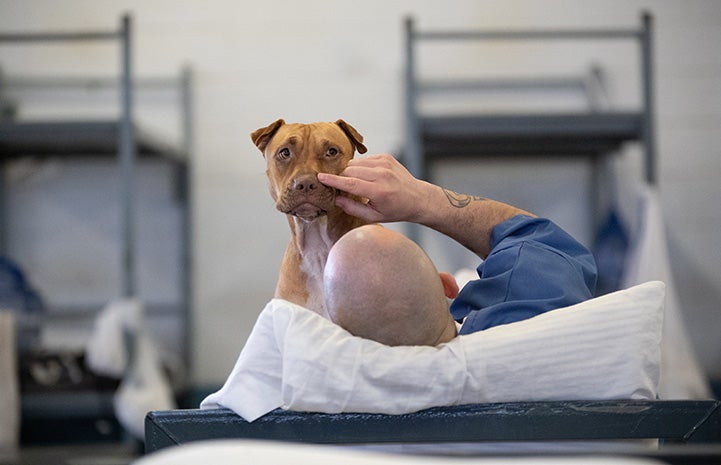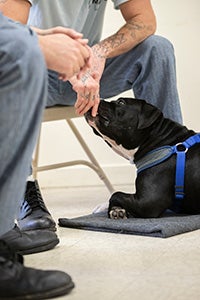Program helps juvenile offenders and shelter dogs get a second chance

The dog’s name was Beauty, but she was a mess. After spending the first part of her life locked in an outdoor shed with limited food and water for days at a time, the small gray dog was terrified of everything and missing most of her fur.
Beauty’s life, however, was about to get so much better. She found her way into a program that provided her with close companionship 24 hours a day, not to mention positive training to help her become adoptable.
There was just one hiccup: As soon as she met her new friends — her caregivers and trainers — she hid under the bed. Her unlikely caregiving team, two teenage boys living at a Florida Department of Juvenile Justice facility in Jacksonville, refused to give up on her, though. And their commitment would more than pay off.

First, a bit of context. Beauty and her caregivers met as part of a program called Teaching Animals and Individuals Life Skills, or TAILS. The innovative program began in Florida’s adult prisons in 2013 and, in 2018, expanded to help juvenile offenders.
Spearheaded by Jen Deane, founder of a Florida animal rescue organization called Pit Sisters, TAILS focuses on providing intensive training for shelter dogs with behavioral issues. In the years since its inception, TAILS has gained a reputation for successfully rehabilitating dogfighting victims, animal cruelty survivors and other dogs who’ve had a tough journey in life.
“We don’t take the easy dogs. We take the hard ones,” Jen says. “Chewing, barking and potty-training are the top three reasons dogs are turned in to the shelter. We teach the dogs the skills they need to be successful in a home.”
About the Best Friends Network
A program that teaches empathy, compassion and teamwork
 And it’s working. To date, according to Jen, more than 500 dogs have graduated from the TAILS program in Florida’s adult correctional facilities. They’ve all been adopted into permanent, loving homes, and not one of them has been returned to a shelter. “None of them,” Jen emphasizes.
And it’s working. To date, according to Jen, more than 500 dogs have graduated from the TAILS program in Florida’s adult correctional facilities. They’ve all been adopted into permanent, loving homes, and not one of them has been returned to a shelter. “None of them,” Jen emphasizes.
The positive impact on the community goes beyond the dogs finding forever homes and the families who adopt them acquiring wonderful new companions. “The people who do the training are helped at the same time,” Jen explains. “They learn empathy. They learn compassion. They learn teamwork. And they develop the ability to work with people they don’t necessarily agree with. For a lot of these guys, this is the first time they’ve gotten unconditional love.”
The program’s success with such previously difficult-to-place animals is aligned with Best Friends’ call to action, Save Them All, and efforts to bring the country to no-kill by 2025. “I agree 100 percent with trying to save them all,’” Jen says. “The closer we get to no-kill, the more critical it is to focus on bigger dogs with behavioral issues. We’re not going to get there unless we can find ways to help these dogs.”
An unbreakable bond
TAILS might not have expanded into Florida’s juvenile justice facilities had it not been for a story about TAILS first published in a 2016 edition of Best Friends magazine.
Penny Alsop works as chief of contract development and planning for the Florida Department of Juvenile Justice’s residential services and she had been mulling ways to help more at-risk kids experience the healing effects of the human-animal bond. Like many states, Florida already had a number of animal-focused programs to help rehabilitate people in the justice system. However, Penny was open to learning about others, and she was transfixed by the article about the work TAILS was doing with inmates.
“I came from a super rough childhood myself, and I can say that a dog saved my life,” Penny says. “My dog was my best friend — my everything. I have an in-depth appreciation for what animals can do for traumatized individuals because I experienced it myself. Animals can get into those crevices of one’s mind and heart where sometimes people just can’t.”
While reading the Best Friends story, Penny realized that the founder of TAILS was based in Jacksonville, Florida. “I didn’t even finish the article before I emailed Jen,” she recalls. “Jen responded right away — it was perfect!”

Expanding TAILS to juvenile offenders
Soon after observing the TAILS program in adult prisons, Penny and her colleagues zeroed in on an ideal juvenile facility to have teens try their hand at training dogs. The Duval Youth Academy in Jacksonville was in close proximity to Jen, so in January 2018, TAILS launched there with three dogs, all rescued from cruelty in the same home.
 Shiloh, Penny (coincidentally) and, of course, Beauty already knew each other and got along well, and when a certified canine behavior consultant assessed them, they showed no signs of aggression — a key requirement for dogs in a juvenile setting.
Shiloh, Penny (coincidentally) and, of course, Beauty already knew each other and got along well, and when a certified canine behavior consultant assessed them, they showed no signs of aggression — a key requirement for dogs in a juvenile setting.
As she does in the TAILS program for adults, Jen paired each dog with a two-member team: one trainer and one handler. Boys must apply for, and get accepted into, the program. Once accepted, they must sign a code of ethics pledging not to yell at their dogs, hit their dogs, or engage in other harmful or negative behavior.
Jen, a certified professional dog trainer, teaches the teens about proper care, training and safety before the dogs arrive at the facility. When the dogs show up, the boys receive ongoing training and supervision from Jen and a designated facility staff member.
After spending about three months fulfilling rigorous training and caregiving regimens with their canine pals, the six selected boys received coveted certificates of completion at an emotional graduation ceremony in April 2018. The certificates can help the teens secure jobs working with animals when they are released. Even more good news? All three of the dogs were adopted. One of them went home with the family of a teen who helped with the dog’s training.
Expanded program will help more youth and more dogs
Three more dogs and their teenage trainers celebrated a second TAILS graduation at Duval Youth Academy in December 2018. Plans are in the works to expand the program to a girls facility in Gainesville and to a brand-new boys facility in central Florida.
“This is so valuable because virtually all of the kids we see have experienced trauma in one way or another in their very short lives,” says Penny. “A dog has a way of reminding you of your inherent goodness. You have to see and feel for your own self what your value is in the world in order to continue on a healthy trajectory.”
As one of the boys (K.T.) who worked with Beauty puts it: “I felt bad for her (previous) mistreatment. As our time together went by, we grew a bond no one can break. We taught each other things that will help us -- like confidence, love, compassion and patience. She helped change my life.”
How dogs can help inmates make positive changes
Dr. Jennifer Wesely, a professor in the University of North Florida’s Department of Criminology and Criminal Justice, says that the teenage years are an ideal time to intervene in a troubled person’s life. In fact, she has come to believe that programs like TAILS can help keep juvenile offenders from ever entering the adult prison system.
“In adolescence, their brains are still developing, so they have significant potential to change and shift to a future that is positive,” Jennifer says. “It’s especially true if their relationships with the dogs are as strong as with the male inmates I’ve worked with.”
She has been studying the effects of the TAILS program on incarcerated men in Florida and has seen that “toxic masculinity” can be “interrupted” when a man who once relied on violence or anger forms a close relationship with a rescued dog who really needs him.
“The men start to see themselves through their animals’ eyes, which allows them to see themselves the way other people see them,” she explains. “They have an identity shift through their dogs. They learn responsibility, commitment, self-control, self-confidence, trust — and they see that it trickles down the leash. The guys learn that they have to adjust their own emotional barometers in order to train the dogs successfully.”
The teens who trained Beauty experienced something like this. Of Beauty, K.T. says: “She was a little stubborn at first, not wanting to listen. But I took my time with her and learned how to become patient.”
K.T.’s training teammate, K.W., clearly enjoyed witnessing the progress that Beauty made once she got the help and love she needed. “She never knew how to sit, she never knew ‘down’ or ‘stay,’ how to wait for food, or how to walk with a leash,” he says. But that has all changed now.

Making a lifesaving difference for dogs
 Penny says she’s thrilled to see how much the dogs connected with the teens and, quite simply, rocked their world in a very short span of time. “I’ve heard young person after young person say, ‘That dog was thrown away — just like me,’” Penny says. “They’re very moved by realizing that the dogs otherwise would have been killed almost assuredly without their care.”
Penny says she’s thrilled to see how much the dogs connected with the teens and, quite simply, rocked their world in a very short span of time. “I’ve heard young person after young person say, ‘That dog was thrown away — just like me,’” Penny says. “They’re very moved by realizing that the dogs otherwise would have been killed almost assuredly without their care.”
While the TAILS program may not be the only solution for these boys as they transition to their next chapters, it certainly is a valued piece of the puzzle. Penny says: “I don’t think an animal-intervention program like this is all that’s needed, because these are complex issues. But this is one way to help these kids.”
It all comes down to the basics, really. “We all respond to kindness. We all respond to love. We all do,” Penny says. “If a chord is struck with a young person at the right moment, it can make a big difference.” And it sure can make a lifesaving difference for dogs who need some extra help to get adopted.
This article originally appeared in Best Friends magazine. You can subscribe to the magazine by becoming a Best Friends member.
Photos by AGoldPhoto